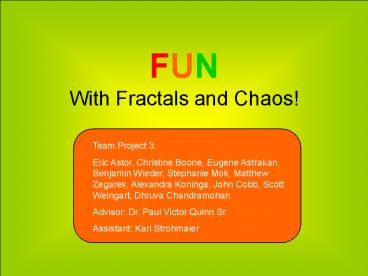FUN With Fractals and Chaos! PowerPoint PPT Presentation
1 / 39
Title: FUN With Fractals and Chaos!
1
FUN With Fractals and Chaos!
Team Project 3 Eric Astor, Christine Boone,
Eugene Astrakan, Benjamin Wieder, Stephanie Mok,
Matthew Zegarek, Alexandra Konings, John Cobb,
Scott Weingart, Dhruva Chandramohan Advisor Dr.
Paul Victor Quinn Sr. Assistant Karl Strohmaier
2
What is a Fractal?
- Exhibits self-similarity
- Unique dimensionality
- Based on recursive algorithms
- Scale independent
3
Sections
- Fractal Dimensions
- Sierpinski n-gons
- Nature Fractals
- Physics Fractals
- Mandelbrot/Julia Set
- Chaos Theory
- Bouncing Ball Model
4
What is the Fractal Dimension?
- Non-integer dimension in which various patterns
exist - Characteristics of a fractal can be determined by
calculating the value of its dimension
5
How is the value of the fractal dimension
calculated?
- Box Counting Method
- Count number of occupied boxes
- Plot ln(occupied boxes) vs. ln(1/boxes per side)
- Slope gives fractal dimension
Fractal Dimension
6
Geometric Formula
- Dimension ln (self similar pieces)
- ln (magnification)
D ln 4 ln 2
- Smaller magnification improves accuracy
7
Sierpinski Fractals
- Named for Polish mathematician Waclaw Sierpinski
- Involve basic geometric polygons
8
Sierpinski Triangle
9
Sierpinski Triangle
10
Sierpinski Square
11
Sierpinski Carpet
12
Sierpinski Carpet
13
Other Sierpinski Polygons
14
The SURACE 17-gon
15
Sierpinski Chaos Game
Vertex 1
Midpoint
New Starting Point
Starting Point
Vertex 2
Vertex 3
16
Sierpinski Chaos Game
- 100 pts
17
Sierpinski Chaos Game
- 1000 pts
18
Sierpinski Chaos Game
- 5000 pts
19
Sierpinski Chaos Game
- 20000 pts
20
Sierpinski Triangle Data
Fractal dimension 1.8175
21
Fractals in Nature
Fractal Fern
- Initial X,Y starting point randomly chosen
- Probabilities indicate equation
- Plot X,Y coordinate
- Last generated X,Y values- inputs for next
iteration
Probability Xn1 Yn1
0.01 0 0.16Yn
0.85 0.85Xn 0.04Yn -0.04Xn 0.85Yn 1.6
0.07 0.20Xn 0.26Yn 0.23Xn 0.24Yn 0.44
0.07 -0.15Xn 0.28Yn 0.26Xn 0.24Yn 0.44
22
Computer-Generated Fractal Tree (100,000
iterations)
Computer-Generated Fractal Fern (100,000
iterations)
23
Fractal Fern and Tree Data
Fern Dimension 1.5142
Tree Dimension 1.6222
24
- Physics Fractals
- Two-Dimensional
- Gingerbread man map
- Lozi structure
- Henon structure
- Henon and Lozi structures used in
calculating comet orbits - Gingerbread man map derived from fluid
equation - Generated using recursive equations
- Three-Dimensional
- Rössler attractor
- Lorenz attractor
- Derived from Navier- Stokes equations
- Generated using differential equations
25
Henon Structure 50,000 iterations
Lozi Structure 100,000 iterations
Gingerbread Man Map 100,000 iterations
26
Rössler attractor 100,000 iterations
Lorenz attractor 100,000 iterations
27
The Mandelbrot Set
Benoit Mandelbrot - 1975
28
Mandelbrot Set
- z0 c
- zn1 zn2 c
- Points in set zn stays finite as n grows
infinitely - Coloring based on how quickly zn diverges
29
Mandelbrot Set
- Self-Similarity
30
Julia Sets
- Fix c in zn1 zn2 c
- Allow z0 to vary
- Each Julia set corresponds to a point in the
Mandelbrot set
31
Julia Sets
- Inside
- Outside
- Border
32
Chaos Theory
- Developed through work of Edward Lorenz in
1960s - Led to famous butterfly effect
- Describes underlying order of random events
- Future behavior difficult or impossible to
predict
33
Bifurcation Graphs
Logistic equation- xn1rxn(1-xn)
- Single line starting point
- Branching
- Becomes dense and indecipherable
- Dimension 1.724
34
Feigenbaums Constant
- Feigenbaum - 1975
- Describes functions approaching chaos
- Branches break off at certain decreasing values
of r - Limit as n approaches infinity of Ln/Ln1 where L
is the length of a branch
- Approaches 4.669
35
Bouncing Ball Simulation
- Bouncing Ball on a Vibrating Bed
- Ybed sine function
- Vibrational strength of bed described by G
G (A?2) / g
A amplitude of vibration ? angular velocity
of vibration g acceleration due to gravity
36
Fractal Nature of the Simulation
- At small G values ball bounces with single
definite collision frequency
- At larger G values ball stabilizes to bouncing
with multiple frequencies
37
Further Analysis of the Simulation
- Can frequency bifurcation be shown in a graph?
- Higher-precision program created
- Fourier transform to resolve frequencies
- No conclusive results
- Fourier transform insufficient
- More sophisticated analysis needed to get
bifurcation - Balls path multiple parabolas
- Possible properties
- Overall equation of path cycloid, complicated
- Collision frequency shows bifurcation, more
numeric analysis needed
38
Resonance
- For some G, maximum height greater than normal
- Collisions at same phase shift
- Ball receives same impulse
39
Future Applications and Studies
- Analyze and Generate the Organ and Organelle
Fractals - All have fractal dimensions between 2 and 3--
must be generated in 3 dimensions
Examples Include Brain Bronchial
Tubes Arteries Membranes
- Analyze and Generate Fractals in Additional
Spatial Dimensions - Analysis only through math and computers
- Box-Counting method not applicable

